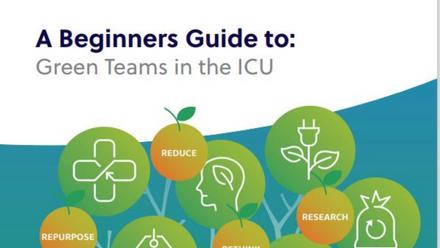In 2021 the Intensive Care Society published our Immediate Climate Strategy, in which we committed to measuring our carbon footprint. The goal of this work was to calculate the environmental impact of our usual activities and identify areas where we could make reductions.
Climate change is the greatest current threat faced by humanity, and we are determined not only to do our part to reduce its causes, but to lead the way for our peers to do the same.
Since 2021 we worked hard to facilitate sustainable change within intensive care. We have provided guidance on sustainable practice, have been working closely with our community to change behaviour relating to the use of PPE, and have begun to collaborate internationally on a sustainability guidance package for critical care. However, while much of our sustainability work is about helping critical care units minimise the environmental impact of their work, it is important that we also take steps to minimise our own.
Further to our Immediate Climate Strategy, in 2023 we released Your Society – Our Strategy – 2023-2027, which identified environmental sustainability as a critical enabler of all our work. As such, we made a commitment to reduce our carbon footprint by 50% by 2030.
To make this reduction we first needed to measure the footprint of our current activities. This will be an annual endeavour, and this initial report and the emissions it describes cover the period from 1 January 2022 to 31 December 2022.
With many organisations calculating their carbon footprint, there are now tools freely available for use in measuring carbon emissions. We used some of these tools to calculate ours in three separate stages; our office space and procurement, the impact of our staff working from home, and the carbon emitted as a result of our team commuting to our London office.
To measure the impact of running our office space we used a free tool available to all Small to Medium Enterprises (SMEs) called The Business Carbon Calculator, by Normative . This tool uses our expenses data, divided and described according to the resource type it relates to. This calculation process is described in more detail on pages 6-11.
In measuring the carbon footprint of our staff working from home we used government guidance, Greenhouse gas reporting: conversion factors 2022 . This tool provided us with emissions factors for both electricity and heating for the average home office, which we combined with the frequency with which staff work from home to arrive at our total working from home emissions. The details of these calculations are described on pages 12-14.
The carbon footprint of our staff commuting to our London office was calculated using a variety of information sources, including the government guidance mentioned above and data available via Transport for London . We also conducted a survey of all staff regarding commuting distances and methods. These calculations are described in detail on pages 15-19.
The emissions described in this report include those relating to the everyday operation of our London-based office, the procurement conducted as part of our usual activities and our staff both working from home and commuting into our office. They do not include any of the emissions related to our annual State of the Art Congress (SOA) other than the staff travel to and from Belfast for the event in June 2022. We will begin calculating the emissions relating to our Congress during the planning and organisational phase of SOA 2024, which will take place in Liverpool.
This report seeks to outline our emissions so we can begin the work to meet our 2030 goal of a 50% reduction.
We hope this report will encourage other organisations like ours to undertake their own calculations, and that it provides a roadmap for how they might do so.


